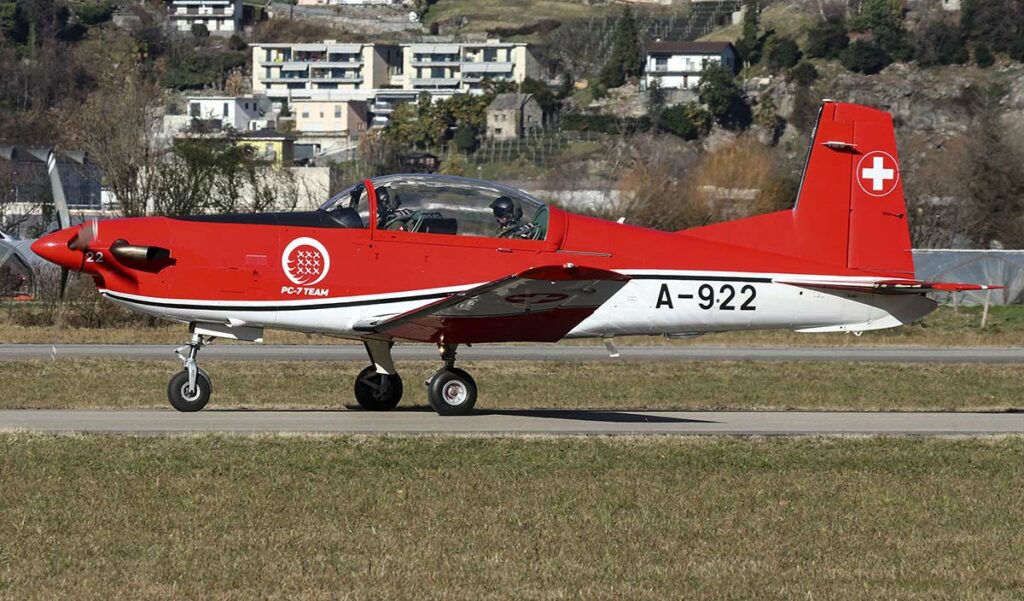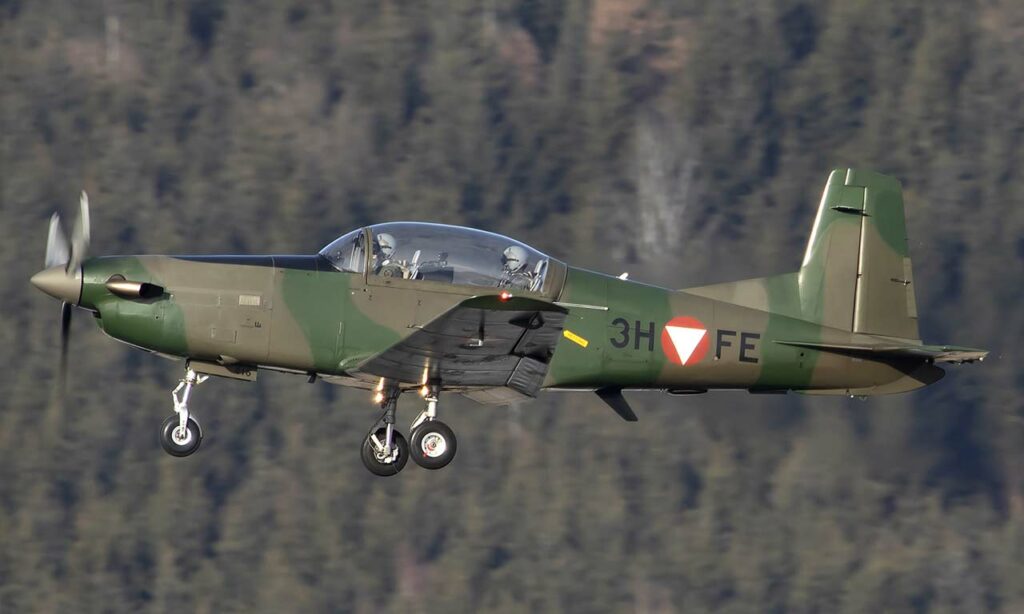Swiss-made basic trainer aircraft, widely used for military pilot training with robust features and excellent handling.
In brief
The Pilatus PC-7 is a low-wing, tandem-seat training aircraft, developed by Pilatus Aircraft of Switzerland. It is powered by a single Pratt & Whitney PT6A-25A turboprop engine, delivering 550 horsepower. The PC-7 features a maximum speed of 270 knots, a range of 900 nautical miles, and a service ceiling of 33,000 feet. Known for its reliability and ease of maintenance, the aircraft is equipped with basic avionics suitable for both VFR and IFR training. Since its first flight in 1966, the PC-7 has been adopted by more than 20 air forces globally, serving as a fundamental tool in pilot training programs due to its cost-effectiveness and operational versatility.

History of the Development of the Pilatus PC-7
In the mid-1960s, amidst the evolving dynamics of military training requirements, Pilatus Aircraft identified a market need for a new type of training aircraft that could bridge the gap between initial propeller-driven trainers and advanced jet trainers. This was a period marked by technological transitions in aviation, with many air forces seeking more efficient and adaptable training solutions for their new generations of pilots.
Pilatus, a Swiss company already noted for its robust utility aircraft, initiated the PC-7 program to develop a turboprop trainer that combined simplicity, low operating costs, and effective training capabilities. The design goals included good low-speed handling, robustness for frequent operation, and versatility to adapt to various training stages. The program officially started in the early 1960s, and the prototype PC-7 first took to the skies on April 12, 1966.
The PC-7 was developed without a specific NATO nickname, which is typical for aircraft that do not fall directly into the NATO inventory or those predominantly used outside of NATO member countries. The aircraft’s development aimed to offer an advanced yet economical solution for military training, filling a niche that was somewhat overlooked at the time.
Design of the Pilatus PC-7
The Pilatus PC-7’s design is characterized by its aerodynamically efficient low-wing configuration, which provides stability and good visibility for trainee pilots and instructors. It measures 10.13 meters in length and has a wingspan of 10.4 meters. The construction primarily uses conventional aluminum alloys, which keeps maintenance straightforward and cost-effective.
The cockpit of the PC-7 is designed for both pilot and instructor to sit in tandem, with dual controls to facilitate interactive flight training. Its avionics are intentionally basic to focus on fundamental flying skills but are sufficient for training pilots on both visual and instrument flight rules. The aircraft’s single engine, a Pratt & Whitney PT6A-25A, is a reliable turboprop known for its durability and ease of operation, producing 550 horsepower which drives a three-blade constant-speed propeller.
While the PC-7 is praised for its flying qualities and low operating costs, one drawback is its limited capability in advanced combat training scenarios, such as those requiring radar or advanced weapons systems. However, its strength lies in its role as a primary trainer, where complex systems are unnecessary.
Performance of the Pilatus PC-7
In operational terms, the Pilatus PC-7 performs admirably with a top speed of 270 knots and a range of 900 nautical miles. Its service ceiling of 33,000 feet allows for high-altitude flight training exercises. The aircraft’s performance is optimized for training missions, with excellent maneuverability, easy handling, and a forgiving nature, which are critical for instructional environments.
Compared to competitors like the Beechcraft T-6 Texan II, the PC-7 may not match in terms of advanced avionics or higher speed capabilities; however, it excels in cost-effectiveness and operational reliability. Many air forces and flight schools prefer the PC-7 for these reasons, as it provides an optimal balance between performance and operating costs.
Variants of the Pilatus PC-7
The PC-7 has several variants, including the upgraded PC-7 MkII, which offers enhanced avionics and an improved engine. Another variant is the PC-7 Turbo Trainer, which features slight modifications in design to improve aerodynamic performance and student comfort.

Military use and combat of the Pilatus PC-7
The Pilatus PC-7 is primarily used as a training aircraft rather than a combat platform. It has been employed by more than 20 air forces worldwide to provide basic and sometimes advanced flight training. Its armament capabilities are limited; however, some versions are capable of carrying light weapons for training purposes. This includes practice bombs and rocket pods to simulate light attack missions.
The PC-7’s significance lies in its role in enhancing pilot proficiency before transitioning to more complex aircraft. Although not involved directly in combat, the skills it imparts are crucial for the effective use of more advanced fighter jets in various air forces. The aircraft continues to be in service in numerous countries, with ongoing orders and deliveries reflecting its enduring value in military training.
The Pilatus PC-7 stands as a testament to the effectiveness of focusing on specific training needs within military aviation. Its design and performance cater precisely to the requirements of basic flight training, proving that an aircraft does not have to be overly complex to be profoundly valuable. Its widespread adoption and continued use underscore its success as a fundamental training tool in global aviation.
Back to the Trainers section.